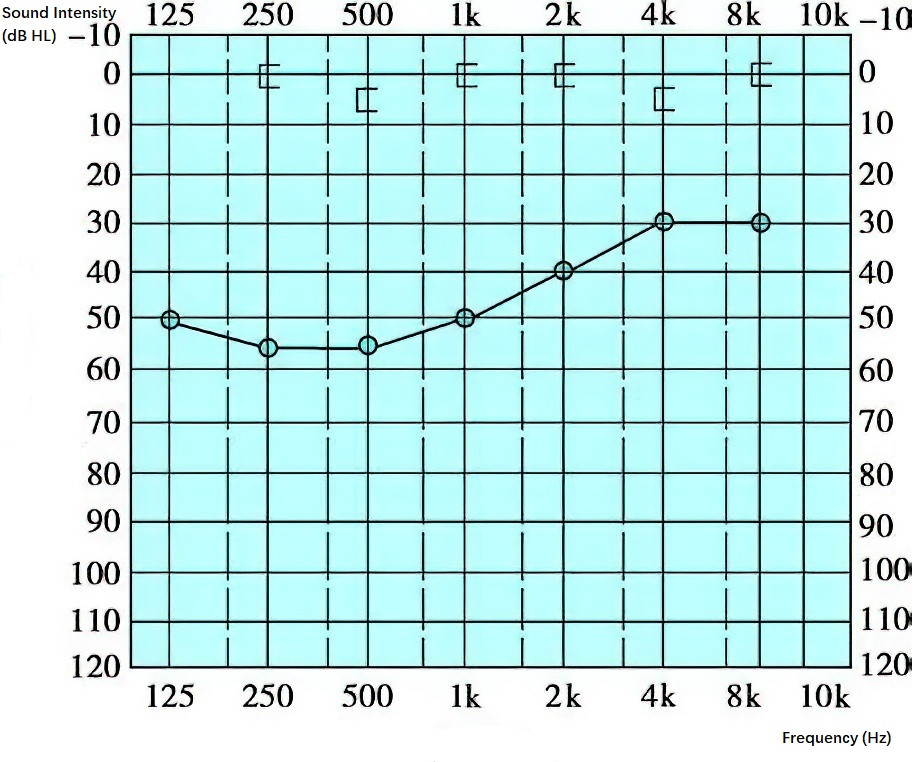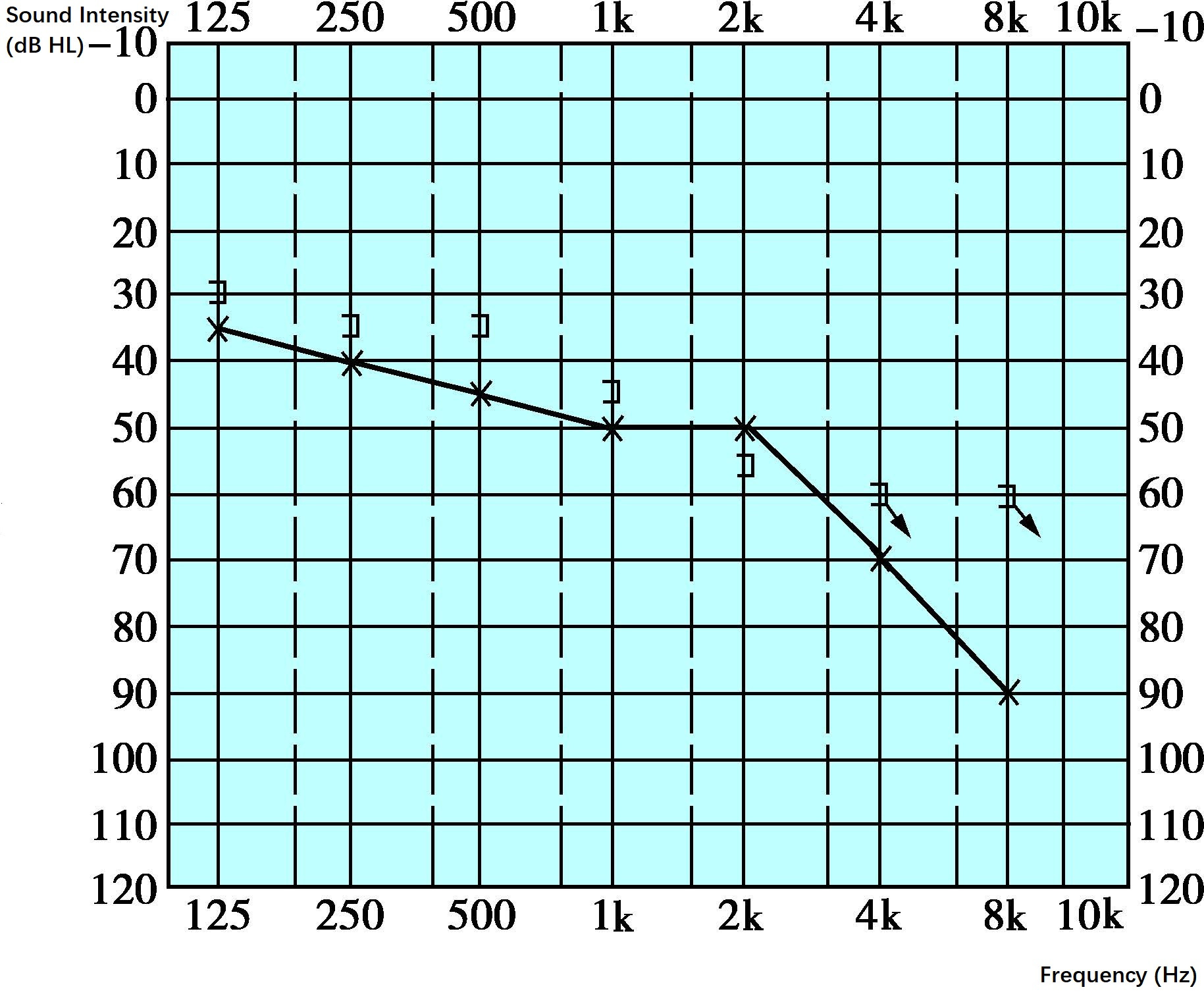A pure tone audiometer generates pure tone sounds at different frequencies through an audio oscillator, with adjustable intensity (sound level). It is used to test hearing sensitivity across various frequencies within the range of human hearing, determine the presence of hearing impairment, estimate the degree of hearing loss, and make a preliminary determination of the type and location of auditory pathology. Hearing thresholds are determined based on whether the individual can perceive sound emitted from the headphones at each frequency, with the lowest audible sound level representing the hearing threshold. These thresholds are plotted on an audiogram, resulting in a hearing curve.
The frequency range of common pure tone audiometers spans 125–10,000 Hz. Frequencies below 250 Hz are considered low-frequency; 500–2,000 Hz represent the mid-frequency range, often referred to as speech frequencies; frequencies above 4,000 Hz fall within the high-frequency range. The frequency range for ultra-high frequency audiometry is 8,000–16,000 Hz (most audiometers cannot exceed 10,000 Hz). The average hearing threshold for speech frequencies is calculated by adding the thresholds at 500 Hz, 1,000 Hz, 2,000 Hz, and 4,000 Hz and dividing the sum by four.
Sound intensity is expressed in decibels (dB). The sound pressure level (SPL) is the objective physical measurement of sound intensity, while the sensation level (SL) represents the suprathreshold sound intensity relative to the individual's hearing threshold. The hearing level (HL) is the sound level relative to the reference hearing threshold (hearing zero level). Both sensation and hearing levels are relative measures based on the sound pressure level. Human ears have varying SPL thresholds at different frequencies, so the SPL values corresponding to hearing zero levels (measured in dB SPL) vary across frequencies. The hearing zero level is the average hearing threshold in dB nHL measured in young individuals with normal hearing under specific SPL conditions. Calibration of audiometers should be performed periodically in soundproof rooms with ambient noise levels below 28 dB(A).
The intensity units of pure tone audiometers are expressed as dB nHL, commonly simplified as dB, with level adjustments made in 5 dB increments. Hearing threshold refers to the minimum sound intensity sufficient to evoke hearing. Elevated thresholds indicate decreased hearing ability. Bone conduction hearing arises from vibrations of the skull that stimulate the inner ear's bony and membranous labyrinths directly, bypassing the middle ear, so bone conduction thresholds clinically reflect inner ear function. Air conduction thresholds represent sound transmitted through the outer and middle ear to the inner ear, making them a measure of the middle ear's conductive function.
Pure Tone Audiometry Threshold Testing
Pure tone threshold testing includes both air conduction and bone conduction tests. Typically, air conduction thresholds are tested first, followed by bone conduction thresholds. Testing generally starts at 1 kHz and proceeds in the following order: 2 kHz, 3 kHz, 4 kHz, 6 kHz, 8 kHz, 250 Hz, and 500 Hz, with 1 kHz retested at the end for consistency. For initial testing, a 1 kHz signal at 40 dB is provided. If the tone is audible, the level is reduced in 5 dB steps until the threshold is determined; the level is then decreased by another 5 dB, and further confirmation is made to ensure the test signal is indeed below the threshold. If the 40 dB signal is not heard, the intensity is increased until the threshold is reached. Clinical methods include ascending and descending approaches, applied based on the examiner's experience.
For bone conduction testing, the bone conduction headset is positioned on the mastoid region of the ear being tested, or alternatively on the midline of the forehead. Noise masking is applied to the opposite ear. The testing procedures and steps are similar to those for air conduction. In addition to using air conduction headphones, free-field audiometry can also be used, where sound is emitted from speakers arranged around a soundproof room, creating a free sound field. This method is primarily employed for children and for individuals using hearing aids or cochlear implants.
When testing pure tone thresholds, the masking method is applied as necessary. This process involves introducing noise to the non-test ear to temporarily elevate its hearing threshold. In cases where the bone or air conduction thresholds in the poorer ear are being tested, the test signal may reach the opposite, healthier ear through crossover attenuation, producing a "shadow curve" similar to the audiogram of the healthier ear. Because bone conduction attenuation across the skull is only 0–10 dB, masking is typically applied to the opposite ear when conducting bone conduction tests. For air conduction, sound bypassing or traveling through the skull to the opposite ear may attenuate by 30–40 dB. When the difference in air conduction thresholds between ears is ≥40 dB, or when testing the poorer-ear air conduction, masking is also required for the opposite ear.
The noise level for masking is typically set around 40 dB SL above the opposite ear's threshold and adjusted based on the situation. Most audiometers provide automated settings for masking noise intensity. Common types of masking noise include white noise and narrowband noise, with narrowband noise centered on the test tone frequency being frequently used.
Analysis of the Pure Tone Audiogram
The pure tone audiogram uses frequency (Hz) as the horizontal axis and sound intensity (dB) as the vertical axis to record the hearing thresholds of the test ear at various frequencies. The air conduction and bone conduction hearing thresholds at each frequency are connected using symbols to form what is known as the audiogram or hearing curve. When there is no response at the maximum sound intensity for a given frequency, a downward arrow ("↓") is placed at that level. The "↓" symbol is not connected to symbols from adjacent frequencies.
Under normal conditions, both the air conduction and bone conduction threshold curves lie within 25 dB, with the gap between air and bone conduction thresholds being less than 10 dB. A situation where air conduction thresholds are higher than bone conduction thresholds suggests conductive hearing loss, while bone conduction thresholds exceeding air conduction thresholds are generally not observed. Audiometers of various models can automatically print audiograms with specific threshold symbols, and interpretation should follow the symbol system of the particular audiometer.
Maximum sound intensity output varies depending on the audiometer and frequency tested:
- The maximum air conduction output ranges between 90–110 dB HL.
- The maximum bone conduction output is approximately 60 dB HL, often lower than 60 dB HL at lower frequencies.
Conductive Hearing Loss
In cases of conductive hearing loss, the bone conduction thresholds for all frequencies are normal or near-normal, whereas the air conduction thresholds are elevated. The elevation of air conduction thresholds is particularly pronounced in the low-frequency range, resulting in an upward-sloping curve. The air-bone gap (ABG), which refers to the difference between air and bone conduction thresholds, is most significant in the low frequencies, exceeding 10 dB. In severe cases of conductive hearing loss, the air conduction curve becomes flat, with the air-bone gap remaining uniform across frequencies.
- When tympanic membrane perforation leads to a flat hearing curve, the air-bone gap can reach 40 dB, often indicating ossicular chain disruption.
- An air-bone gap greater than 45 dB in cases of tympanic membrane perforation may suggest tympanosclerosis or potential measurement error.
- Intact tympanic membrane cases with conductive hearing loss may exhibit an air-bone gap of up to 60 dB, which could indicate complete ossicular chain fixation or disruption, as seen with otosclerosis or ossicular malformations.

Figure 1 Conductive hearing loss (Right ear)
Sensorineural Hearing Loss
Since both air and bone conduction pathways ultimately transmit sound to the inner ear, the hearing curves for air and bone conduction in sensorineural hearing loss demonstrate a consistent decline. High-frequency hearing loss is typically more pronounced, resulting in a sloping downward curve, or in steeply sloping cases for severe losses. Low-frequency thresholds may also be elevated in cases of severe sensorineural hearing loss, producing a flat curve.
- Cases with hearing preservation at only select frequencies are referred to as "island hearing".
- For sudden sensorineural hearing loss, hearing recovery following treatment typically begins with low frequencies, with mid-to-high frequencies recovering more slowly.
- Sensorineural hearing loss predominantly affecting low frequencies may suggest early-stage Meniere's disease. In such cases, the audiogram exhibits a rising curve, with a peak around 2,000 Hz and slightly decreasing thresholds at higher frequencies. Early-stage Meniere’s disease may also show a fluctuation tendency in audiograms, eventually progressing to a flat curve as the disease advances. Associated conditions include low-frequency sudden sensorineural hearing loss, auditory neuropathy, and autoimmune-related hearing loss.

Figure 2 Sensorineural hearing loss (Left ear)
Mixed Hearing Loss
The audiogram for mixed hearing loss exhibits characteristics of both conductive and sensorineural hearing losses. Both air and bone conduction thresholds are elevated, but an air-bone gap is present.
- The audiogram often shows features of low-frequency conductive hearing loss combined with a consistent decline in air and bone conduction thresholds at higher frequencies.
- In some cases, there are reductions in air and bone conduction thresholds across all frequencies, with a noticeable air-bone gap persisting.
Specific pathologies may demonstrate unique patterns. For example, fixation of the ossicular chain or otosclerosis may result in an elevated bone conduction threshold around the ossicular chain’s resonance frequency at 2,000 Hz, a phenomenon known as the Carhart notch. While the audiogram of such cases shows an accompanying air-bone gap, these patterns indicate conductive hearing loss rather than mixed hearing loss.

Figure 3 Mixed hearing loss (Right ear)